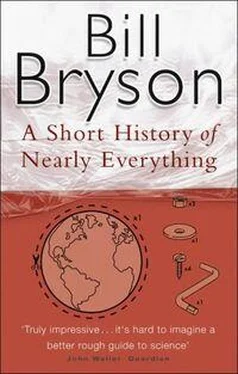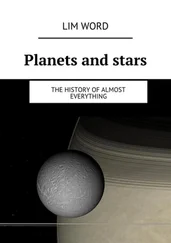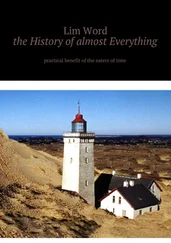“G. K. Gilbert of Columbia University . . .” Lewis, Rain of Iron and Ice , p. 38.
“Gilbert conducted these experiments . . .” Powell, Night Comes to the Cretaceous , p. 37.
“only slightly more than a dozen of these things . . .” Transcript from BBC Horizon documentary “New Asteroid Danger,” p. 4, first transmitted March 18, 1999.
“He called them asteroids-Latin for ‘starlike . . .’ ” Science News , “A Rocky Bicentennial,” July 28, 2001, pp. 61-63.
“it was finally tracked down in 2000 . . .” Ferris, Seeing in the Dark , p. 150.
“twenty-six thousand asteroids had been named and identified . . .” Science News , “A Rocky Bicentennial,” July 28, 2001, pp. 61-63.
“cruising at sixty-six thousand miles an hour . . .” Ferris, Seeing in the Dark , p. 147.
“all of which are capable of colliding . . .” Transcript from BBC Horizon documentary “New Asteroid Danger,” p. 5, first transmitted March 18, 1999.
“such near misses probably happen . . .” New Yorker , “Is This the End?” January 27, 1997, pp. 44-52.
“some thirty thousand metric tons of ‘cosmic spherules’ . . .” Vernon, Beneath Our Feet , p. 191.
“Well, they were very charming . . .” Frank Asaro, telephone interview by author, March 10, 2002.
“an article in Popular Astronomy magazine . . .” Powell, Mysteries of Terra Firma , p. 184.
“the dinosaurs may have been dealt a death blow . . .” Peebles, Asteroids: A History , p. 170.
“an earlier event known as the Frasnian extinction.” Lewis, Rain of Iron and Ice , p. 107.
“They’re more like stamp collectors . . .” Quoted by Officer and Page, Tales of the Earth , p. 142.
“even while conceding in a newspaper interview . . .” Boston Globe , “Dinosaur Extinction Theory Backed,” December 16, 1985.
“continued to believe that the extinction of the dinosaurs . . .” Peebles, p. 175.
“evaluate Manure Management Plans . . .” Iowa Department of Natural Resources Publication, Iowa Geology 1999: Number 24.
“Suddenly we were at the center of things . . .” Ray Anderson and Brian Witzke, interview by author, Iowa City, June 15, 2001.
“One of those moments came . . .” Boston Globe , “Dinosaur Extinction Theory Backed,” December 16, 1985.
“The formation had been found by Pemex . . .” Peebles, pp. 177-78; and Washington Post , “Incoming,” April 19, 1998.
“I remember harboring some strong initial doubts . . .” Gould, Dinosaur in a Haystack , p. 162.
“Jupiter will swallow these comets up . . .” Quoted by Peebles, p. 196.
“One fragment, known as Nucleus G . . .” Peebles, p. 202.
“Shoemaker was killed instantly . . .” Peebles, p. 204.
“nearly every standing thing would be flattened . . .” Anderson, Iowa Department of Natural Resources: Iowa Geology 1999 , “Iowa’s Mansion Impact Structure.”
“fleeing would mean ‘selecting a slow death over a quick one . . .’ ” Lewis, Rain of Iron and Ice , p. 209.
“concluded that it affected Earth’s climate for about ten thousand years . . .” Arizona Republic , “Impact Theory Gains New Supporters,” March 3, 2001.
“our missiles are not designed for space work . . .” Lewis, Rain of Iron and Ice , p. 215.
“even a year’s warning would probably be insufficient . . .” New York Times magazine, “The Asteroids Are Coming! The Asteroids Are Coming!” July 28, 1996, pp. 17-19.
“Shoemaker-Levy 9 had been orbiting Jupiter . . .” Ferris, Seeing in the Dark , p. 168.
CHAPTER 14 THE FIRE BELOW
“It was a dumb place to look for bones . . .” Mike Voorhies, interview by author, Ashfall Fossil Beds State Park, Nebraska, June 13, 2001.
“At first they thought the animals were buried alive . . .” National Geographic , “Ancient Ashfall Creates Pompeii of Prehistoric Animals,” January 1981, p. 66.
“far better than we understand the interior of the earth.” Feynman, p. 60.
“The distance from the surface of Earth . . .” Williams and Montaigne, Surviving Galeras , p. 78.
“A modest fellow, he never referred to the scale . . .” Ozima, The Earth , p. 49.
“It rises exponentially . . .” Officer and Page, Tales of the Earth, p. 33.
“sixty thousand people were dead . . .” Officer and Page, p. 52.
“the city waiting to die . . .” McGuire, A Guide to the End of the World , p. 21.
“the potential economic cost . . .” McGuire, p. 130.
“collapsed scaffolding erected around the Capitol Building . . .” Trefil, 101 Things You Don’t Know About Science and No One Else Does Either , p. 158.
“became known, all but inevitably, as the Mohole . . .” Vogel, p. 37.
“using a strand of spaghetti . . .” Valley News , “Drilling the Ocean Floor for Earth’s Deep Secrets,” August 21, 1995.
“about 0.3 percent of the planet’s volume . . .” Schopf, Cradle of Life , p. 73.
“We also know a little bit about the mantle . . .” McPhee, In Suspect Terrain , pp. 16-18.
“Scientists are generally agreed . . .” Scientific American , “Sculpting the Earth from Inside Out,” March 2001, pp. 40-47; and New Scientist , “Journey to the Centre of the Earth” supplement, October 14, 2000, p. 1.
“By all the laws of geophysics . . .” Earth , “Mystery in the High Sierra,” June 1996, p. 16.
“The rocks are viscous . . .” Vogel, p. 31.
“The movements occur not just laterally . . .” Science , “Much About Motion in the Mantle,” February 1, 2002, p. 982.
“an English vicar named Osmond Fisher presciently suggested . . .” Tudge, The Time Before History , p. 43.
“then had suddenly found out about wind.” Vogel, p. 53.
“there are two sets of data . . .” Trefil, 101 Things You Don’t Know About Science and No One Else Does Either , p. 146.
“82 percent of the Earth’s volume . . .” Nature , “The Earth’s Mantle,” August 2, 2001, pp. 501-6.
“something over three million times . . .” Drury, p. 50.
“during the age of the dinosaurs . . .” New Scientist , “Dynamo Support,” March 10, 2001, p. 27.
“37 million years appears to be the longest stretch . . .” New Scientist , “Dynamo Support,” March 10, 2001, p. 27.
“the greatest unanswered question . . .” Trefil, 101 Things You Don’t Know About Science and No One Else Does Either , p. 150.
“Geologists and geophysicists rarely go . . .” Vogel, p. 139.
“The seismologists resolutely based their conclusions . . .” Fisher et al., Volcanoes , p. 24.
“It was the biggest landslide in human history . . .” Thompson, Volcano Cowboys , p. 118.
“the force of five hundred Hiroshima-sized atomic bombs,” Williams and Montaigne, p. 7.
“Fifty-seven people were killed.” Fisher et al., p. 12.
Читать дальше












